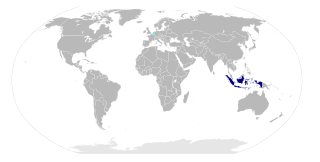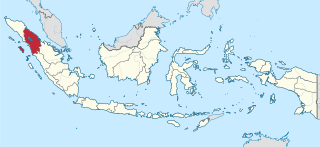
Indonesian is the official and national language of Indonesia. It is a standardized variety of Malay, an Austronesian language that has been used as a lingua franca in the multilingual Indonesian archipelago for centuries. Indonesia is the fourth most populous nation in the world, with over 270 million inhabitants—of which the majority speak Indonesian, which makes it one of the most widely spoken languages in the world.

The Austronesian languages are a language family widely spoken throughout Maritime Southeast Asia, Madagascar, the islands of the Pacific Ocean and Taiwan. There are also a number of speakers in continental Asia. They are spoken by about 386 million people. This makes it the fifth-largest language family by number of speakers. Major Austronesian languages include Malay, Javanese, Sundanese, and Tagalog (Filipino). According to some estimates, the family contains 1,257 languages, which is the second most of any language family.

Riau is a province of Indonesia. It is located on the central eastern coast of Sumatra along the Strait of Malacca. The province shares land borders with North Sumatra to the northwest, West Sumatra to the west, and Jambi to the south. According to the 2020 census, Riau had a population of 6,394,087 across a land area of 87,023.66 square kilometres; the official estimate as at mid 2021 was 6,493,603. The province comprises ten regencies and two cities, with Pekanbaru serving as the capital and largest city.

Medan is the capital and largest city of the Indonesian province of North Sumatra, as well as a regional hub and financial centre of Sumatra. According to the National Development Planning Agency, Medan is one of the four main central cities of Indonesia, alongside Jakarta, Surabaya, and Makassar. As of the 2020 Census, Medan has a population of 2,435,252 within its city limits, and over 3.4 million in its built-up urban area, making it the fourth largest urban area in Indonesia. The Medan metropolitan area—which includes neighbouring Binjai, Deli Serdang Regency, and a part of Karo Regency—is the largest metropolitan area outside of Java, with 4,744,323 residents counted in the 2020 Census. Medan is a multicultural metropolis and a busy trading city bordered by the Strait of Malacca, making it one of the major economic cities in Indonesia. A gateway to the western part of Indonesia, Medan is supported by the Port of Belawan and Kualanamu International Airport, both of which are connected to the city centre via toll roads and railways.

Indonesian cuisine is a collection of various regional culinary traditions that formed the archipelagic nation of Indonesia. There are a wide variety of recipes and cuisines in part because Indonesia is composed of approximately 6,000 populated islands of the total 17,508 in the world's largest archipelago, with more than 1,300 ethnic groups. Many regional cuisines exist, often based upon indigenous culture with some foreign influences. Indonesia has around 5,350 traditional recipes, with 30 of them considered the most important. Indonesia's cuisine may include rice, noodle and soup dishes in modest local eateries to street-side snacks and top-dollar plates.

North Sumatra is a province of Indonesia located on the northern part of the island of Sumatra. Its capital and largest city is Medan. North Sumatra is Indonesia's fourth most populous province after West Java, East Java and Central Java, and also the most populous in the island of Sumatra. It also the most populous province outside of the island of Java. It covers an area of 72,981 km2. According to the 2020 census, the province's population in that year was 14,799,361. The mid-2022 official estimate is 15,115,206.

The Riau Islands is a province of Indonesia. It comprises a total of 1,796 islands scattered between Sumatra, Malay Peninsula, and Borneo including the Riau Archipelago. Situated on one of the world's busiest shipping lanes along the Malacca Strait and the South China Sea, the province shares water borders with neighboring countries such as Singapore, Malaysia, and Brunei. The Riau Islands also have relatively large potential mineral resources and energy, as well as marine resources. The capital of the province is Tanjung Pinang and the largest city is Batam.

Greenlandic is an Eskimo–Aleut language with about 57,000 speakers, mostly Greenlandic Inuit in Greenland. It is closely related to the Inuit languages in Canada such as Inuktitut. It is the most widely spoken Eskimo–Aleut language.

Batak is a collective term used to identify a number of closely related Austronesian ethnic groups predominantly found in North Sumatra, Indonesia, who speak Batak languages. The term is used to include the Karo, Pakpak, Simalungun, Toba, Angkola, and Mandailing which are related groups with distinct languages and traditional customs (adat).

Indonesian slang, or informal Indonesian language is a term that subsumes various vernacular and non-standard styles of expression used throughout Indonesia that are not necessarily mutually intelligible. Regional slang from the capital of Jakarta, based on Betawi language, is however heavily exposed and promoted in national media, and considered the de facto Indonesian slang. Despite its direct origins, Indonesian slang often differs quite significantly in both vocabulary and grammatical structure from the most standard form of Indonesia's national language. These expressions are neither standardized nor taught in any formal establishments, but rather function in daily discourse, usually in informal settings. Several dictionaries of bahasa gaul has been published. Indonesian speakers regularly mix several regional slangs in their conversations regardless of origin, but depending on the audience and the familiarity level with the listeners.

Bahorok or Bohorok is a district of Langkat Regency. Its capital is Bohorok town, and Bukit Lawang is a major local tourist attraction for viewing orangutans.

Northern Qiang is a Sino-Tibetan language of the Qiangic branch, more specifically falling under the Tibeto-Burman family. It is spoken by approximately 60,000 people in East Tibet, and in north-central Sichuan Province, China.
Aʼingae, commonly known as Cofán or Kofán, is the primary language of the Aʼi (Cofán) people, an indigenous group whose ancestral territory lies at the interface between the Andean foothills and Amazonia in the northeast of Ecuador and southern Colombia.

The Karo, or Karonese, are a people of the Tanah Karo and part of the Batak people from North Sumatera, Indonesia. The Karo lands consist of Karo Regency, plus neighboring areas in East Aceh Regency, Langkat Regency, Dairi Regency, Simalungun Regency and Deli Serdang Regency. In addition, the cities of Binjai and Medan, both bordered by Deli Serdang Regency, contain significant Karo populations, particularly in the Padang Bulan area of Medan. The town of Sibolangit, Deli Serdang Regency in the foothills on the road from Medan to Berastagi is also a significant Karo town.

Indonesian literature is a term grouping various genres of South-East Asian literature.
Abui is a non-Austronesian language of the Alor Archipelago. It is spoken in the central part of Alor Island in Eastern Indonesia, East Nusa Tenggara (NTT) province by the Abui people. The native name in the Takalelang dialect is Abui tanga which literally translates as 'mountain language'.
Maybrat is a Papuan language spoken in the central parts of the Bird's Head Peninsula in the Indonesian province of Southwest Papua.

The Aru was a major Sumatran kingdom from the 13th to the 16th century. It was located on the eastern coast of North Sumatra, Indonesia. In its heyday the kingdom was a formidable maritime power, and was able to control the northern part of the Malacca strait.

The COVID-19 pandemic in Indonesia is part of the ongoing worldwide pandemic of coronavirus disease 2019 caused by severe acute respiratory syndrome coronavirus 2. It was confirmed to have spread to Indonesia on 2 March 2020, after a dance instructor and her mother tested positive for the virus. Both were infected from a Japanese national.
2021 (MMXXI) was a common year starting on Friday of the Gregorian calendar, the 2021st year of the Common Era (CE) and Anno Domini (AD) designations, the 21st year of the 3rd millennium and the 21st century, and the 2nd year of the 2020s decade.
















